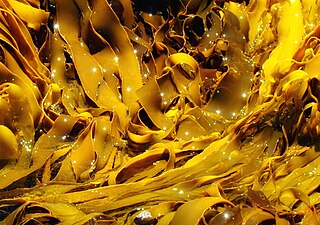
AlgaeBase is a global species database of information on all groups of algae, both marine and freshwater, as well as sea-grass.

AlgaeBase is a global species database of information on all groups of algae, both marine and freshwater, as well as sea-grass.
AlgaeBase began in March 1996, [1] [2] founded by Michael Guiry. [3]
By 2005, the database contained about 65,000 names. [4]
In 2013, AlgaeBase and the Flanders Marine Institute (VLIZ) signed an end-user license agreement regarding the Electronic Intellectual Property of AlgaeBase. This allows the World Register of Marine Species (WoRMS) to include taxonomic names of algae in WoRMS, thereby allowing WoRMS, as part of the Aphia database, to make its overview of all described marine species more complete. Synchronisation of the AlgaeBase data with Aphia and WoRMS was undertaken manually until March 2015, but this was very time-consuming, so an online application was developed to semi-automate the synchronisation, launching in 2015 in conjunction with Michael Guiry and the chief programmer of AlgaeBase, Pier Kuipers. After a long phase of further development and testing, the AlgaeBase harvester tool was implemented by the WoRMS data management team in early 2019. Since then, newly-added species in AlgaeBase are added to Aphia and, if marine, to WoRMS as well. [3]
The database is hosted at the National University of Ireland's Ryan Institute, in Galway. [3] It includes about all types of algae, [4] as well as one group of flowering plants, the sea-grasses. [1] Information about each species' taxonomy, nomenclature and distribution is included, and the algae covered include terrestrial as well as marine and freshwater species, such as seaweeds, phytoplankton, and freshwater algae. As of 2019 [update] , marine species have the best coverage, and sea-grass is included, although it is a flowering plant rather than an alga. [3]
As of 2014 there were nearly 17,000 images, and the database was being used by 2,000–3,000 individual visitors each day. [2]
As of 2023, there were about 170,000 species and infraspecies in AlgaeBase. [1]
The compilation of the data was funded by the Irish Government Department of Education and Science's Programme for Research in Third-level Institutions (PRTLI) 2, 3 and 4 programmes, to the Ryan Institute and the Environmental Change Institute, as well as by Atlantic Philanthropies, and the European Union. [5]
The synchronisation between AlgaeBase and Aphia was possible through support of the LifeWatch Species Information Backbone. LifeWatch, the E-Science European Infrastructure for Biodiversity and Ecosystem Research, is a distributed virtual laboratory, which is used for different aspects of biodiversity research. [3]
As of 2022 [update] , the main sponsors of the database are the Phycological Society of America, the British Phycological Society, the International Phycological Society, and the Korean Phycological Society. Programming is carried out by Pier Kuipers and Caoilte Guiry, and Michael Guiry. Jonathan Guthrie was responsible for programming much of earlier versions. [1]

Phycology is the scientific study of algae. Also known as algology, phycology is a branch of life science.

Leathesia marina (Lyngbye) Decaisne, 1842, previously known as Leathesia difformis Areschoug, 1847, commonly known as the sea cauliflower the sea potato, and brown brains is a species of littoral brown algae in the class Phaeophyceae and the order Ectocarpales, which is commonly attached to other seaweeds and sometimes rocks. When young, the organism is solid but as it matures it becomes hollow and somewhat convoluted and has the appearance of a small leathery brown bag about the same size as a tennis ball. The texture is rubbery and the outer surface smooth.

Atractophora hypnoides is a rare red alga (Rhodophyta) found in the British Isles, France and some Atlantic Islands and is the only species of the genus found in the British Isles. It is attached to the rock or other algae by a small basal disc and is much branched with downgrowing filaments which enclose the main branch or axis forming a cortex. Short filaments of limited growth radiate in whorls from the axis and frequently convert into hairs. The spreading filaments grow irregularly in a diffuse manner. Microscope examination is required for identification.
Schmitzia hiscockiana is a small, rare, red seaweed or marine alga of the phylum Rhodophyta or red algae. It was discovered and named in 1985.
The history of phycology is the history of the scientific study of algae. Human interest in plants as food goes back into the origins of the species, and knowledge of algae can be traced back more than two thousand years. However, only in the last three hundred years has that knowledge evolved into a rapidly developing science.
The World Register of Marine Species (WoRMS) is a taxonomic database that aims to provide an authoritative and comprehensive list of names of marine organisms.

The Rivulariaceae are a family of cyanobacteria within the Nostocales in which the filaments (trichomes) are tapered from wider at the base to narrower at the tip.

Ulva intestinalis is a green alga in the family Ulvaceae, known by the common names sea lettuce, green bait weed, gutweed, and grass kelp. Until they were reclassified by genetic work completed in the early 2000s, the tubular members of the sea lettuce genus Ulva were placed in the genus Enteromorpha.

Bangiales is an order of multicellular red algae of the class Bangiophyceae containing the families Bangiaceae, Granufilaceae, and possibly the extinct genus Rafatazmia with one species, Rafatazmia chitrakootensis. They are one of the oldest eukaryotic organisms, possibly dating back to 1.6 billion years old. Many species are used today as food in different cultures worldwide. Their sizes range from microscopic (Bangiomorpha) to up to two meters long. Many of its species are affected by Pythium porphyrae, a parasitic oomycete. Similar to many other species of red algae, they reproduce both asexually and sexually. They can be both filamentous or foliose, and are found worldwide.

Blidingia marginata is a species of seaweed in the Kornmanniaceae family.
Cyanonephron elegans is a freshwater species of cyanobacteria in the family Synechococcaceae. It is described in the Netherlands, Siberia, Russia and Queensland, Australia.

Batrachospermaceae is a family of fresh water red algae (Rhodophyta). Genera within the Batrachospermaceae generally have a "Lemanea-type" life history with carpospores germinating to produce chantransia. Sporophyte phase with meiosis occurs in an apical cell to produce the gametophyte stage. Pit connections have two pit plug cap layers with the other layer enlarged. This family of freshwater red algae is uniaxial, meaning each filament with a single apical cell. The genera included within Batrachospermaceae are listed in the table below.

Mastocarpus papillatus, sometimes called Turkish washcloth, black tar spot, or grapestone is a species of red algae in the family Phyllophoraceae. It is sometimes confused with the distantly related Turkish towel which is of a similar texture but larger. The specific epithet papillatus is due to the nipple-like projections on the female gametophyte which can give the texture of a terrycloth washcloth found at a Turkish bath.

Odonthalia dentata is a medium-sized marine red alga.

Michael Dominic Richard Guiry, is an Irish botanist, who specialises in phycology (algae). See for example the articles. He is the founder and director of the algal database, AlgaeBase.
The British Phycological Society, founded in 1952, is a learned society based in the United Kingdom promoting the study of algae. Members interests include all aspects of the study of algae, including both natural biodiversity and applied uses. It is the largest learned phycological society in Europe. Its membership is worldwide, although predominantly within the UK.

Lithophyllum incrustans, also known by its common names coraline crust and paint weed, is a small pinkish species of seaweed.